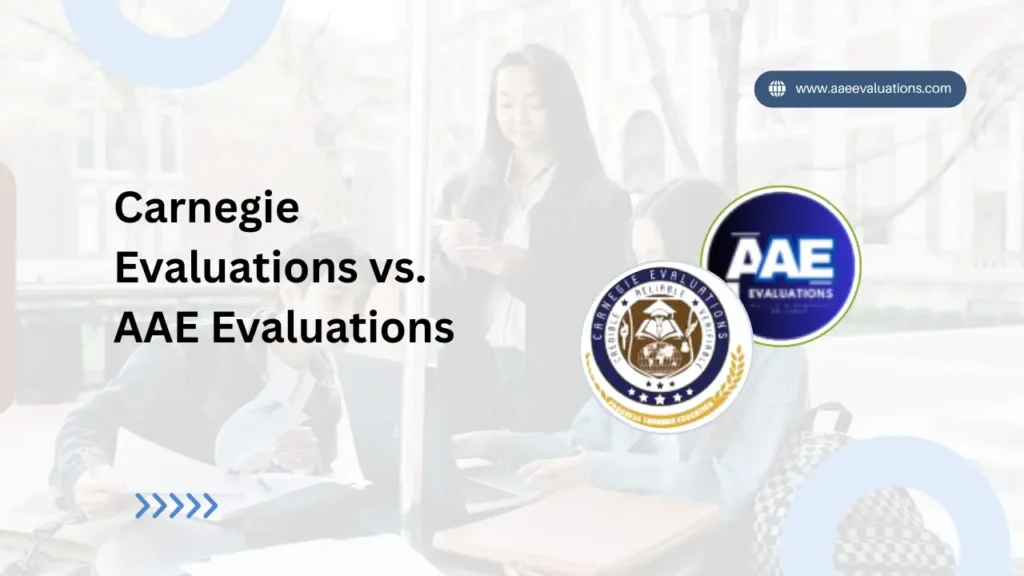Credential vs. Position Evaluation for U.S. Immigration: Key Differences Explained
When it comes to U.S. immigration, whether you’re applying for a work visa, a green card, or any other immigration benefit, understanding the requirements and processes involved is essential for a smooth application. Among the many requirements, position evaluations and credential evaluations are two terms that often arise. Despite their similarities in purpose, these evaluations focus on different aspects of your qualifications and are used for distinct purposes within the immigration process.
If you are unfamiliar with the terms, or if you’re unsure whether you need one or both of these evaluations for your immigration case, this post will clear up the confusion. We’ll explore what each evaluation is, why they matter, and how they differ, giving you the clarity needed to navigate your U.S. immigration journey more confidently.
At AAE Evaluations, we specialize in providing both credential evaluations and position evaluations to help applicants navigate the complexities of U.S. immigration. Our expert team is committed to ensuring your qualifications meet the requirements for your immigration goals.
What is a Credential Evaluation?
A credential evaluation is a detailed assessment of your foreign academic credentials to determine their U.S. equivalency. This evaluation is often required when you have earned a degree, diploma, or other educational qualifications outside of the United States and need to demonstrate that these credentials meet U.S. educational standards.
In many cases, U.S. immigration authorities or employers may require this evaluation to ensure that your academic qualifications align with those typically required for specific visa categories. For instance, if you are applying for an H-1B visa (for specialty occupations), you must prove that you have a U.S. equivalent degree. If your degree was obtained from a foreign institution, a credential evaluation is necessary.
Why is a Credential Evaluation Important?
The primary purpose of a credential evaluation is to verify that your foreign educational qualifications are equivalent to U.S. standards. This is particularly important for employment-based immigration applications where educational qualifications are a key requirement. Many U.S. immigration visa categories — such as the H-1B, EB-2, or O-1 — require proof that the applicant holds a degree comparable to the U.S. degree that is typically required for the specific occupation.
Credential evaluations are also crucial when you’re applying for a U.S. job that requires a degree from an accredited institution. The evaluation serves as evidence that your foreign qualifications are considered equivalent to U.S. degrees, which helps employers and U.S. immigration officials understand your level of education in a familiar context.
At AAE Evaluations, our team of experts provides detailed and accurate credential evaluations to help you meet immigration or employment requirements. We ensure that your foreign qualifications are properly assessed and compared to U.S. standards.
Types of Credential Evaluations
Credential evaluations come in two main types:
- General Evaluation: This type provides a broad comparison of your degree to the U.S. equivalent. It’s typically used when you need a simple report stating that your foreign degree is equivalent to a U.S. degree.
- Course-by-Course Evaluation: This more detailed evaluation includes an assessment of individual courses, grades, and credits earned. It’s often required when you need to demonstrate that your foreign degree matches the specific academic requirements for a visa or job role.
How Does a Credential Evaluation Work?
A credential evaluation typically involves submitting your academic documents, such as transcripts, degree certificates, and course descriptions, to a credential evaluator. The evaluator will then review your academic history, comparing your coursework and qualifications to U.S. education standards. Based on this assessment, they will issue a report that outlines the U.S. equivalency of your foreign qualifications.
In some cases, the evaluation report will include the calculation of your U.S. Grade Point Average (GPA), which may be important for visa applications or job offers that require a specific GPA threshold.
When Do You Need a Credential Evaluation?
You will need a credential evaluation if:
- You have a foreign academic background (e.g., a degree, diploma, or certificate) and need to prove its U.S. equivalency.
- You’re applying for a U.S. immigration benefit that requires educational qualifications, such as an H-1B visa or EB-2 green card.
- You’re applying for a job in the U.S. that requires a degree or certification comparable to U.S. standards.
At AAE Evaluations, we help applicants from all over the world get their foreign qualifications evaluated for immigration purposes or employment in the U.S.
What is a Position Evaluation?
A top position evaluation, on the other hand, assesses the job you’re being offered in the U.S. to determine whether it meets the qualifications required for a specific immigration visa category. Unlike credential evaluations, which focus on your educational background, position evaluations focus on the details of the job itself.
Why is a Position Evaluation Important?
The purpose of a position evaluation is to ensure that the job you’re applying for qualifies for the visa you are seeking. Many work-related visas (such as the H-1B and EB-2) require that the job be classified as a specialty occupation that demands a specific level of expertise or education.
For example, a H-1B visa is designed for workers in specialty occupations, typically requiring a bachelor’s degree or higher in a specific field. A position evaluation confirms that the job duties, responsibilities, and qualifications meet the criteria for a specialty occupation, which is crucial for visa approval.
At AAE Evaluations, we help employers and employees assess the qualifications of the job being offered, ensuring that it meets the strict standards required for U.S. immigration applications.
How Does a Position Evaluation Work?
A position evaluation involves an in-depth review of the job description, required qualifications, and job duties to determine whether the position aligns with the requirements of the visa category. The evaluator will typically assess:
- The educational requirements of the job.
- Whether the job requires specialized knowledge.
- The responsibilities and day-to-day tasks associated with the position.
- The salary level to ensure it meets or exceeds the minimum threshold set by the immigration authorities.
This evaluation is typically used to confirm that the role aligns with the specific criteria for visas like the H-1B or EB-2.
At AAE Evaluations, our team performs thorough and detailed position evaluations to ensure that the role you’re applying for meets the necessary requirements for U.S. immigration benefits.
When Do You Need a Position Evaluation?
You will need a position evaluation if:
- You are applying for an employment-based visa (like the H-1B, O-1, or EB-2) and need to prove that the position you are being offered qualifies for the visa.
- Your employer needs to confirm that the job meets the necessary qualifications for immigration purposes.
- You are applying for a U.S. work visa that requires the job to be classified as a specialty occupation or highly specialized.
Key Differences Between Position Evaluations and Credential Evaluations
While both evaluations are critical for U.S. immigration, they serve different functions. To clarify their differences, let’s compare them in the following table:
| Factor | Credential Evaluation | Position Evaluation |
| Focus | Assesses educational credentials for U.S. equivalency. | Assesses job position to determine if it qualifies for a specific U.S. visa category. |
| Who Needs It | Individuals with foreign degrees, diplomas, or certificates. | Employers or foreign workers seeking to apply for a work visa. |
| Purpose | Verifies if foreign education matches U.S. academic standards. | Verifies if the job qualifies for a visa based on job duties and requirements. |
| Use Case | Required for visa categories such as H-1B or EB-2, or when applying for jobs that require U.S. equivalent degrees. | Used for work visas like H-1B, EB-2, O-1 to assess if the job aligns with visa requirements. |
| Example | Bachelor’s degree from a foreign university compared to a U.S. degree. | Job evaluation for an IT specialist applying for a work visa. |
Why Are These Evaluations Important?
Both credential evaluations and position evaluations are integral to the U.S. immigration process. Here’s why each is critical:
- Credential Evaluation: This evaluation ensures that individuals with foreign academic qualifications meet the required standards for specific U.S. visas or immigration benefits. It helps confirm that your educational background is comparable to what is typically required in the U.S.
- Position Evaluation: This evaluation helps to ensure that the job you’re applying for meets the specialized requirements for your visa category. It prevents employers from offering jobs that do not meet the standards for employment-based immigration.
At AAE Evaluations, we provide expert evaluations to support your immigration journey, helping you fulfill both the credential and position evaluation requirements for various visa categories.
How to Get a Credential or Position Evaluation
Credential Evaluation:
- Choose a Qualified Evaluator: Work with a credential evaluator who specializes in U.S. immigration cases. AAE Evaluations offers reliable, professional services.
- Submit Your Academic Documents: Provide copies of your transcripts, degree certificates, and course descriptions.
- Wait for the Report: The evaluator will review your documents and issue a report detailing the U.S. equivalency of your foreign education.
Position Evaluation:
- Consult with an Immigration Professional: An immigration attorney or evaluator can help assess the job.
- Submit Job Details: Provide a comprehensive job description, including responsibilities, qualifications, and educational requirements.
- Obtain the Report: After the evaluation, a report will confirm whether the job qualifies for your visa category.



